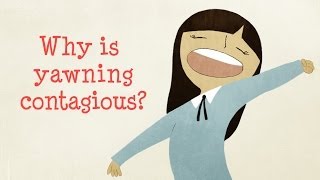(单词翻译:单击)
Oh, excuse me! Have you ever yawned because somebody else yawned?
不好意思!你是否曾因别人打哈欠而打哈欠?
You aren't especially tired, yet suddenly your mouth opens wide and a big yawn comes out.
你并不是十分疲惫,可突然间你的嘴巴就会大张,接着一个大哈欠便产生了。
This phenomenon is known as contagious yawning.
这种现象被称为传染性哈欠。
And while scientists still don't fully understand why it happens,
尽管科学家们还没有完全了解它产生的原因,
there are many hypotheses currently being researched.
但人们目前却正在对许多假说进行研究。
Let's take a look at a few of the most prevalent ones,
下面让我们来看下其中几个最为流行的说法,
beginning with two physiological hypotheses before moving to a psychological one.
我们先从两种生理学的假说入手,接着,我们会再来了解一种心理学的假说。
Our first physiological hypothesis states that contagious yawning is triggered by a specific stimulus, an initial yawn.
第一种生理学假说认为传染性哈欠是由一种特殊的刺激因素所导致,那就是最初的哈欠。
This is called fixed action pattern.
这被称作固定行为模式。
Think of fixed action pattern like a reflex. Your yawn makes me yawn.
这就好比条件反射。你的哈欠引起我的哈欠。
Similar to a domino effect, one person's yawn triggers a yawn in a person nearby that has observed the act.
这与多米诺效应很相似,一个人的哈欠会引发附近其他看到该行为的个体也打哈欠。
Once this reflex is triggered, it must run its course.
当这种条件反射被激发,它就必须顺其发展。
Have you ever tried to stop a yawn once it has begun? Basically impossible!
你曾试图阻止过自己打哈欠吗?那基本是不可能的!
Another physiological hypothesis is known as non-conscious mimicry, or the chameleon effect.
另一种生理学假说被称为非意识性模仿或变色龙效应。
This occurs when you imitate someone's behavior without knowing it, a subtle and unintentional copycat maneuver.
它发生在人们对他人行为进行无意识模仿时,这种行为通常是细微且无意识的模仿动作。
People tend to mimic each other's postures.
人们常常模仿他人的姿势。
If you are seated across from someone that has their legs crossed, you might cross your own legs.
如果你坐在某人对面,而那个人正翘着二郎腿,你可能也会跷起腿来。
This hypothesis suggests that we yawn when we see someone else yawn
这种假说表明当看到别人打哈欠时我们也会打哈欠,
because we are unconsciously copying his or her behavior.
因为我们会无意识的模仿他人的行为。
Scientists believe that this chameleon effect is possible because of a special set of neurons known as mirror neurons.
科学家们相信这种变色龙效应的可能性是源自一组特殊的神经元,它叫作镜像神经元。
Mirror neurons are a type of brain cell
镜像神经元是一种大脑细胞,
that responds equally when we perform an action as when we see someone else perform the same action.
它促使人们相应地做出自己所看到的他人发出的相同动作。
These neurons are important for learning and self-awareness.
这些神经元十分重要,特别是对学习和自我意识。
For example, watching someone do something physical,
例如,当看到他人的某些动作时,
like knitting or putting on lipstick, can help you do those same actions more accurately.
如编织或是涂口红,它会帮助我们更加准确地做出相同的动作。
Neuroimaging studies using fMRI, functional magnetic resonance imaging,
神经影像研究利用功能性磁共振成像,
show us that when we seem someone yawn or even hear their yawn,
发现当我们看到别人打哈欠或甚至听到别人打哈欠时,
a specific area of the brain housing these mirror neurons tends to light up,
大脑中容纳镜像神经元的特殊区域会产生反应,
which, in turn, causes us to respond with the same action: a yawn!
从而导致人们会做出相同的反应:打哈欠。

Our psychological hypothesis also involves the work of these mirror neurons.
从心理学假说来看,它也涉及到镜像神经元所产生的影响。
We will call it the empathy yawn.
我们称之为共感哈欠。
Empathy is the ability to understand what someone else is feeling and partake in their emotion,
共感是一种理解能力,它使我们体会他人的感受并融入对方的情感,
a crucial ability for social animals like us.
这是一种对于像人类这样的社会性动物来讲十分关键的能力。
Recently, neuroscientists have found that a subset of mirror neurons
最近,神经学家发现镜像神经元的一组子集
allows us to empathize with others' feelings at a deeper level.
使我们能够进一步增进对他人感受的认知。
Scientists discovered this empathetic response to yawning while testing the first hypothesis we mentioned, fixed action pattern.
科学家们对于这种共感性哈欠的发现,源自于对先前提及的第一种假说的验证中,也就是固定行为模式。
This study was set up to show that dogs would enact a yawn reflex at the mere sound of a human yawn.
这项研究是为了证明狗打哈欠的条件反射能够仅通过人类所发出的哈欠声来实现。
While their study showed this to be true, they found something else interesting.
此项研究不仅证明了这一事实,科学家们还发现了另一个有趣的现象。
Dogs yawned more frequently at familiar yawns, such as from their owners, than at unfamiliar yawns from strangers.
熟悉的哈欠对狗的影响更为频繁,比如主人的哈欠,而陌生的哈欠则不那样明显。
Following this research, other studies on humans and primates
随着进一步的探索,其他对于人类及灵长类动物的研究
have also shown that contagious yawning occurs more frequently among friends than strangers.
也证实了哈欠的传染性多发生在朋友而非陌生人之间。
In fact, contagious yawning starts occurring when we are about four or five years old,
事实上,传染性哈欠在我们4、5岁时就已经产生了,
at the point when children develop the ability to identify others' emotions properly.
因为那时的孩子已经能够正确地识别他人的情感。
Still, while newer scientific studies aim to prove that contagious yawning is based on this capacity for empathy,
尽管最新的科学研究致力于证明传染性哈欠是基于共感能力,
more research is needed to shed light on what exactly is going on.
但更多的研究仍在等着我们去解释这其中真正的原因。
It's possible that the answer lies in another hypothesis altogether.
真正的答案或许就在另一个假说中。
The next time you get caught in a yawn, take a second to think about what just happened.
下次你再打哈欠时,停下来想想刚才都发生了什么。
Were you thinking about a yawn? Did someone near you yawn?
你是在想打哈欠这件事吗?附近有其他人打哈欠吗?
Was that person a stranger or someone close? And are you yawning right now?
那个人是陌生人还是熟人?还有你现在在打哈欠吗?


